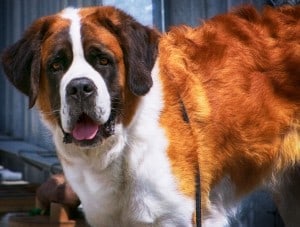Saint Bernards have a long history. The ancestry of the Saint Bernard is unknown, but it is most likely that they descended from the Molussus dogs kept by the Roman armies who invaded during the first two centuries A.D., and a variety of native breeds. Saint Bernards are famous for rescuing stranded travelers in the Swiss Alps, especially those dogs kept by the Archdeacon Bernard de Menthon who kept a Hospice in the Alps in A.D. 1050.
Saint Bernards are very large dogs that can make excellent pets, provided they are properly bred and trained. A well-bred and well-trained Saint Bernard can be one of the most gentle and sweet dogs in the world. Most Saint Bernards are good with children, provided they are well socialized, and can get along well with other animals. They make marvelous guard dogs. Because Saint Bernards are so large and have such a loud, deep bark they are very good at keeping strangers at bay. They can be destructive if poorly bred, poorly trained, or neglected, so it is necessary to begin obedience training early.
Saint Bernards are eager to please their families, and so will try very hard in training, but it is necessary that training be ongoing and consistent. Saint Bernards can be great pets for families with children, provided the dog is socialized to the children as a pup. Because Saint Bernards are so large, children should be supervised while playing with them to avoid an accident. Saint Bernards get along well with most other animals, especially if introduced to them while young, although male Saint Bernards may try to dominate other dogs.

Saint Bernards are large dogs. They reach between 25 and 30 inches in height and can weigh as much as 200 pounds. There are two varieties of Saint Bernard: the shorthaired, with a short, thick coat and the longhaired with a longer, wavy coat. In both varieties, the coat is red and white or brindle and white. Darker colors on the face are common. Saint Bernards have very large, powerful heads with floppy ears. Saint Bernards have powerful legs and a deep, broad chest.Besides being used to rescue travelers, the Saint Bernard was also adept at guarding flocks and homes on Swiss dairy farms, as well as being useful for pulling carts.

In 1888, the Saint Bernard Club of America was organized.Because of their massive size, Saint Bernards are quite prone to both hip and elbow dysplasia. Other problems include lymphoma, bloat, epilepsy, hemophilia, cardiomyopathy, eye problems, osteochondritis dissecans, and osteosarcoma.Saint Bernards need a great deal of exercise, although (like many humans) it is sometimes hard to convince them to exercise. Both the longhaired and shorthaired Saint Bernard should be brushed weekly.

